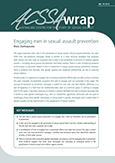Practice Review: Engaging men in sexual assault prevention
This useful summary (described below) of men’s engagement strategies by Mary Stathopoulos of the Australian Centre for the Study of Sexual Assault should be in every preventionist’s reference collection. It is complemented by another report about engaging men released this month, Effectively involving men in preventing violence against women, written by Garth Baker of the New Zealand Family Violence Clearing House.
Source of text below: Australian Institute of Family Studies
 This paper examines men’s role in the prevention of sexual assault. Sexual assault prevention has seen shifts from risk-avoidance messages aimed at women to a more inclusive paradigm that proposes both women and men have an important role to play in the prevention of all forms of violence against women—including sexual assault and domestic and family violence. There is a lack of empirical evidence of the impact or outcomes related to men’s involvement in sexual assault primary prevention. However, there is evidence that indicates that gender equality and respectful relationships are key to reducing sexual violence.
This paper examines men’s role in the prevention of sexual assault. Sexual assault prevention has seen shifts from risk-avoidance messages aimed at women to a more inclusive paradigm that proposes both women and men have an important role to play in the prevention of all forms of violence against women—including sexual assault and domestic and family violence. There is a lack of empirical evidence of the impact or outcomes related to men’s involvement in sexual assault primary prevention. However, there is evidence that indicates that gender equality and respectful relationships are key to reducing sexual violence.
Knowing why it is important to engage men in primary prevention efforts does not tell us how to achieve this goal. Examples of prevention programs that seek to engage men are presented in this paper. The concept of resistance to prevention messages is salient for men who may feel helpless, defensive, or a lack of legitimacy in a field that has traditionally been seen as a feminist space. In seeking to engage men in this space, it becomes necessary to balance a tension between the need to employ language that is based on male gender stereotypes (e.g., men as competitive, aggressive, dominant) with the goal of challenging those same gender stereotypes. A strong belief in gender stereotypes and a weak belief in gender equality are key determinants in the perpetration of sexual violence.
Key messages
- The next step in sexual assault prevention is to engage men – both as facilitators and as participants in prevention.
- If men are to be engaged in the prevention of sexual assault there must be a shared understanding of the fact that men have a positive role to play.
- A consideration of how to engage men in prevention efforts must take into account the ways in which some men may resist prevention messages – whether that resistance stems from discomfort, rejection of ideas, or from other sources.
- There is a tension when masculine gender stereotypes are used as a tool for engaging men in prevention while evidence suggests that these same stereotypes can contribute as underlying factors in the perpetration of sexual assault and violence against women.
Full publication
Authors
Mary Stathopoulos is a Senior Research Officer with the Australian Centre for the Study of Sexual Assault at the Australian Institute of Family Studies.
